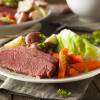The mist lifts and the sun comes out as I walk into a small, dusty settlement in early November. From my vantage point, I can see the slate blue ocean in the distance beyond the dark bare branches of the trees. The unpaved path before me leads between rows of teeny wooden houses, each with its own garden brimming full of herbs, leafy greens and root vegetables. The tantalizing smell of wood smoke is in the air, and my stomach grumbles in response. Something’s cooking. I’m on the hunt to find out what it is. I step forward into Plymouth Colony. The year is 1624.

The 17th century English village at Plimoth Plantation is a living exhibit where interpreters (aka costumed role players) go about their day as the Pilgrims would have done soon after they established a colony here. According to the museum’s Colonial Foodways culinarian Kathleen Wall, they do an awful lot of work. In terms of food, this includes preparation, procurement, preservation and presentation. “The food is prepared in real time,” she explains. Although there were no cookbooks in the original colonists’ inventories, everything that gets made and consumed in the English Village exhibit is planned out by Wall and based on 17th century recipes.
Through an open doorway, I hear giggling and the excited voices of children. I walk inside and see two women in colonial dress working at a table, surrounded by a group of elementary schoolers in bright-colored coats. They pepper the women with questions: “Where do you sleep?” “Do you like living here?” “What are you making?” The women patiently explain that they’re preparing sausages; as one cuts up a hunk of raw pork, the other lines a plate with the meat, adding bits of suet and herbs.
“Are you gonna eat those?” I interrupt eagerly. The kids look up, shocked, but I ignore them, thinking, Hey, just because I’m an adult doesn’t mean I’m not curious, too. One woman nods and tells me the sausages are for the day’s midday meal. She indicates a pot of water hanging over an unlit fire in the corner hearth, where the sausages will be cooked. I turn back toward the table and jam my hand in my pocket, reassured by the feel of 21st century technology in the form of a smartphone. Rays of sunlight stream through the open window onto the table, and I whip my phone out to snap a picture.
Unlike the Puritans, who settled Boston prepared to recreate the lifestyle they’d left behind in England, the Pilgrims decided to make a go of it in the wilderness. They farmed and fished and hunted for almost everything that ended up on their table, learning new skills and adapting to an unfamiliar environment in the process. At most, they expected to have about 200 people in Plymouth Colony. In contrast, the Puritans were expecting at least 2,000 people to arrive to populate their own colony further north, so they were quick to establish markets and small businesses to provide for them. As the founders of Boston, the Puritans were more about trade and commerce than the Pilgrims, who focused on growing and making what they needed for survival.
Since most of the Pilgrims would likely have purchased bread when they lived in England, they had to learn how to bake once they got here. Plimoth Bread Company’s artisan baker, Dr. Tani Mauriello, uses a Pilgrim-style wood-fired oven insulated with clay in the recently renovated craft center to bake “historic bread, bread that is significant to the Plymouth region.” Baskets of soft, rounded balls of dough rest on a marble countertop. Mauriello opens the door of a small modern oven to reveal loaves of thirded bread made with wheat, rye and corn flour, gently baking to a rich golden brown. The end result is dense, chewy and flavorful—the kind of bread you crave for sopping up the leftover sauce on your plate. Available for purchase at the gift shop, Plimoth Bread Company’s baked goods almost always sell out.

Much to the surprise of museum visitors, the foods gathered and eaten by the English settlers in the 1620s were basically the same as those eaten by the native people, the Wampanoag. “They’re eating from the same food shed,” says Wall, “[and] there are only so many different ways you could cook it: you can roast, or you can fry, or you can stew it up.” However, the colonists added precious imported ingredients like butter, sugar and spices to satisfy their longing for a taste of home.
While they missed having access to items we take for granted today, such as apples and pears, the Pilgrims were pleasantly surprised by new goodies: pumpkins, strawberries, beans and plenty of venison. Even back then, the food here was supersized. The colonists wrote tantalizing details to family members back in England about how much bigger everything was in the New World, including lobsters, turkeys, quail and eels. But the most important new ingredient was maize, or corn, which became a staple of their diet in the form of bread, cakes and puddings.
To get a taste of what life was like in 1624, you don’t have to go further than Plimoth Plantation’s visitor center, where you can sample dishes based on colonial English and Native cuisine at the Patuxet Cafe. Groups of 25 or more can book an Eat Like a Pilgrim event and enjoy a themed dining experience that features dishes like cabbage pottage, stewed pumpkin and turkey with onion sauce. Either way, you’ll want to wander the grounds to see what’s cooking (literally) in the English village and at the Wampanoag homesite.
To learn more about Plimoth Plantation, go to plimoth.org.




